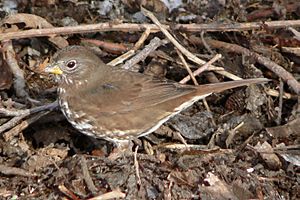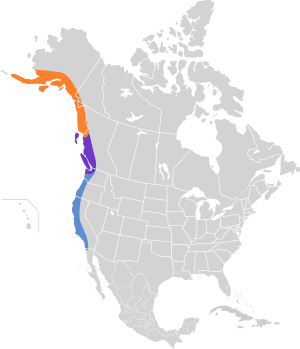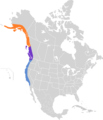Sooty fox sparrow facts for kids
Quick facts for kids Passerella iliaca unalaschcensis |
|
|---|---|
 |
|
| Passerella (iliaca) unalaschcensis in the state of Washington | |
| Scientific classification |
|
| Kingdom: | Animalia |
| Phylum: | Chordata |
| Class: | Aves |
| Order: | Passeriformes |
| Family: | Passerellidae |
| Genus: | Passerella |
| Species: | |
| Subspecies: |
P. i. unalaschcensis
|
| Trinomial name | |
| Passerella iliaca unalaschcensis (Gmelin, 1789)
|
|
 |
|
The sooty fox sparrow (Passerella (iliaca) unalaschcensis) is a bird known for its very dark feathers. It belongs to the Passerella group of birds. Scientists currently consider it a "subspecies group" within the larger fox sparrow family. However, many believe it should be its own separate species.
For a long time, experts thought the sooty fox sparrow was unique because of how it looks. Studies of its DNA have confirmed that it is indeed a special group. This bird seems to be closely related to the thick-billed and slate-colored fox sparrows.
Appearance and Habitat
The sooty fox sparrow's color changes depending on where it lives. Birds in the northern areas are a sandy brown. Those in the southernmost areas are a dark, coffee-like color. Their upper parts and head are brown, and they have streaks of the same color on their undersides.
These birds like to build their nests in willows and alders. They prefer to live near wet areas. Their call sounds like a sharp zitt or thik. Some people describe it as a loud smack.
Different Types of Sooty Fox Sparrows
There are usually six types, or subspecies, of the sooty fox sparrow. These different types live in various places, from the Aleutian Islands to northwestern Washington. Each subspecies has slight differences in appearance or where they live.
- Unalaschcensis (Gmelin, 1789): This type breeds from the Unalaska Island to the Shumagin Islands in Alaska. In winter, they fly south to British Columbia and California.
- Townsendi (Audubon, 1838): This subspecies breeds along the Pacific coast from Glacier Bay to the Queen Charlotte Islands. They are darker and more reddish-brown than the Unalaschcensis type.
- Fuliginosa (Ridgway, 1899): These birds breed from the Stikine River south to northwest Washington. They are even darker and sootier than the Townsendi type.
- Annectens (Ridgway, 1900): This type breeds along the Pacific coast from north Yakutat Bay to Cross Sound. They are a mix between the Sinuosa and Townsendi types.
- Insularis (Ridgway, 1900): This subspecies only breeds on Kodiak Island. They are brighter and more reddish-brown on top.
- Sinuosa (Grinnell, 1910): These birds breed around Prince William Sound and Kenai Peninsula. They have a noticeably thinner bill than other types.
- Chilcatensis (Webster, 1983): This type breeds near the Chilkat River in British Columbia. They are similar to the Fuliginosa type but are duller and have shorter tails.
Images for kids


